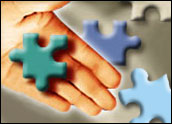
On my blog, I have been writing about my experience with my new computer: an iMac. In addition to the usual functional comparisons, I have been spending a lot of time thinking about the whole cultural difference between the Windows world and the Apple world. As a longtime user of Windows, I felt I knew and understood that platform pretty well and the jolt of cutting over cold turkey was both surprising and refreshing.
The surprises came in discovering some pleasant differences between where I had been and where I was going, and that was mostly on the cultural side. Perhaps the biggest pleasant discovery I had was in the buying process. I had my antennae up, hoping to find something to write about — and I was not disappointed. It was quite an experience, memorable perhaps because I don’t shop much — or at least this way anymore.
I guess I could have bought my computer online from Apple, and that would have been an experience more like my experiences buying PCs. Because I live in the Boston area, though, a place that has a couple of Apple’s 200 stores in the vicinity, I found it easy to hop in the car and go to the mall.
Practicing Patience
There is something about going to a store and getting face-to-face with someone that I bet is primal to being human and as old as a Middle Eastern bazaar. I don’t frequent malls or stores of any kind except food shops — I am a foodie — so when I entered the Apple store and people began waiting on me, my perceptions were heightened. My reaction was, “Aha! I’ve forgotten what this is like,” followed by, “How are we ever going to get this into software?”
I think the short answer is that we’re not. Much as we talk about the customer experience, that experience is subjective, it requires personal input and the best we can hope for is put all the pieces in place and hope that sometimes they’ll all align. The longer answer is a bit more involved. It has to do with the fact that customers are analog, finicky and capricious, and while we might try to apply technology to the equation in the hope of advancing the close, a good customer will prevent that from happening.
I don’t know about you, but my first reaction to the finicky and capricious bit is denial. Not me, I am a logical, rational person who makes decisions when they are called for. I don’t vacillate, compare, change my mind or any of that! Yeah, sure.
Apple knows this and they build it into the sales experience by training their people and practicing patience. If you want to compare things, no sweat, the salespeople are knowledgeable and can point out the similarities and differences. They even know the competition so that they can relate analogous concepts. As I look back on the process, I know I could have made my purchase online, but without a knowledgeable person to work with, I don’t know if I would have crossed over from Windows.
People Buy From People
My experience was business to consumer, and much of CRM is aimed at the business-to-business world, but I think the growing success of CRM 2.0 is showing us that even in the B2B world, people buy from people. It makes me wonder sometimes why we still try to sell CRM as an aid to advancing or speeding up the sales process, for example, rather than diving deeper into the reality of the relationship. Perhaps the short answer is that we can’t. A company with thousands or even millions of customers can’t have relationships in any meaningful sense with its customers. In contrast, the customer may have a relationship with a brand, but again that gets us back to B2C and CRM 2.0.
CRM 2.0 appears to me to be the next best thing to developing relationships with millions of customers because it lets customers build relationships with each other. In that way, the relationship is both expanded and transferred, offloading a great deal of labor and expense.
Letting customers pursue their relationships with their favorite brands as and, most importantly, when they choose, is key to success. CRM then becomes the tool for — forgive this metaphor — keeping all the balls in the air, rather than the tool for catching any one of them. Of course we still need all the forecasting, reporting and charting tools we can get our hands on because CRM is also about trying to make sense out of chaos. Nevertheless, every now and then I think it’s useful to consider the fact that that, regardless of what we’re selling or what channel we’re in, we are dealing with people on the other side.
Denis Pombriant is the managing principal of the Beagle Research Group, a CRM market research firm and consultancy. Pombriant’s research concentrates on evolving product ideas and emerging companies in the sales, marketing and call center disciplines. His research is freely distributed through a blog and Web site. He is working on a book and can be reached at [email protected].























































